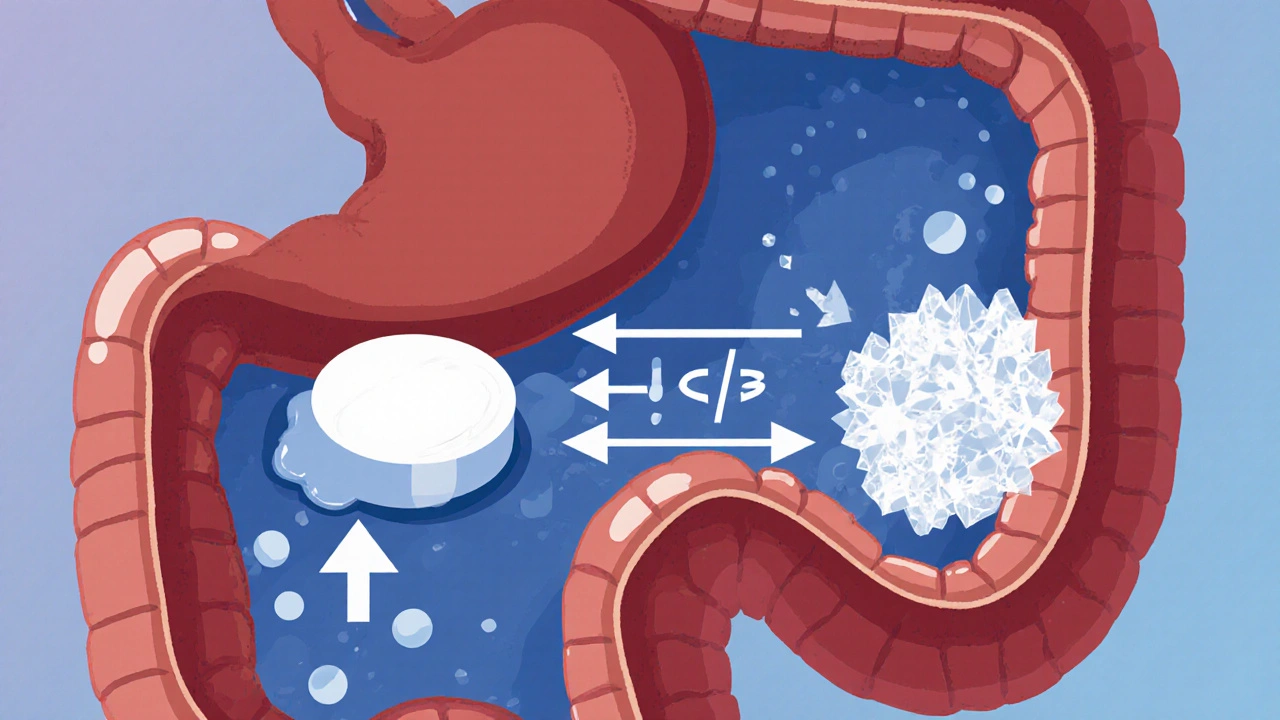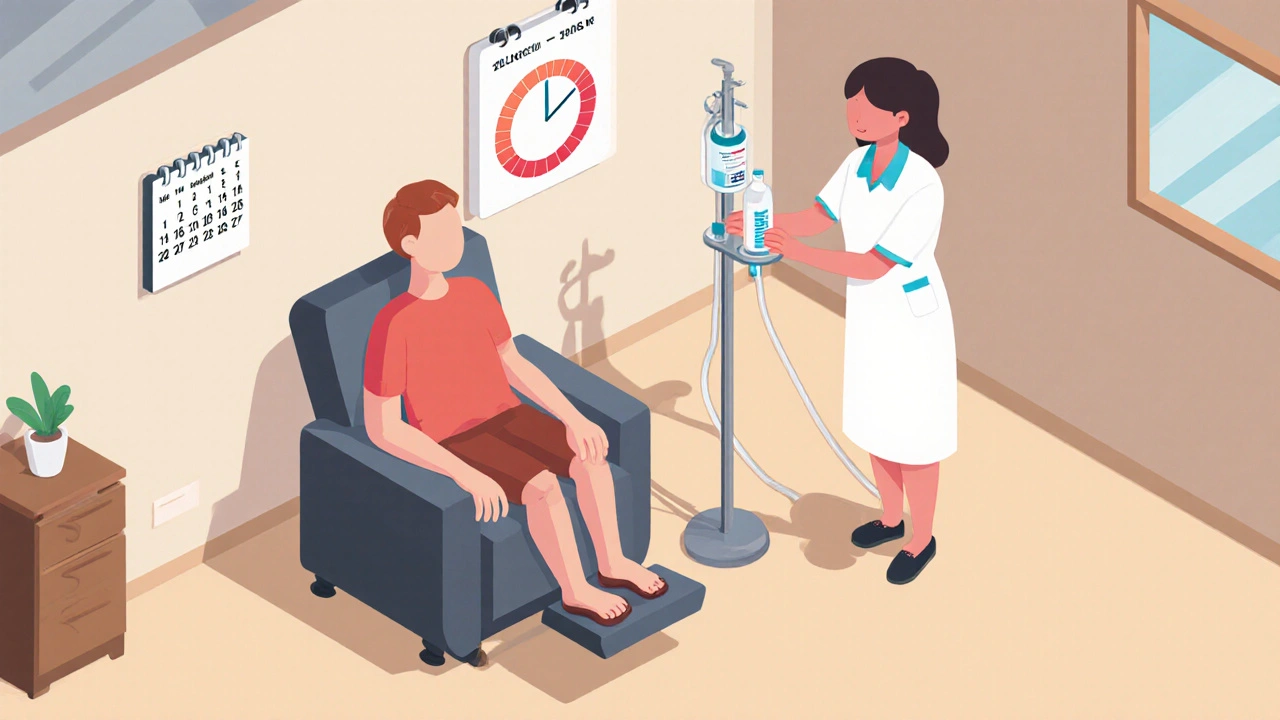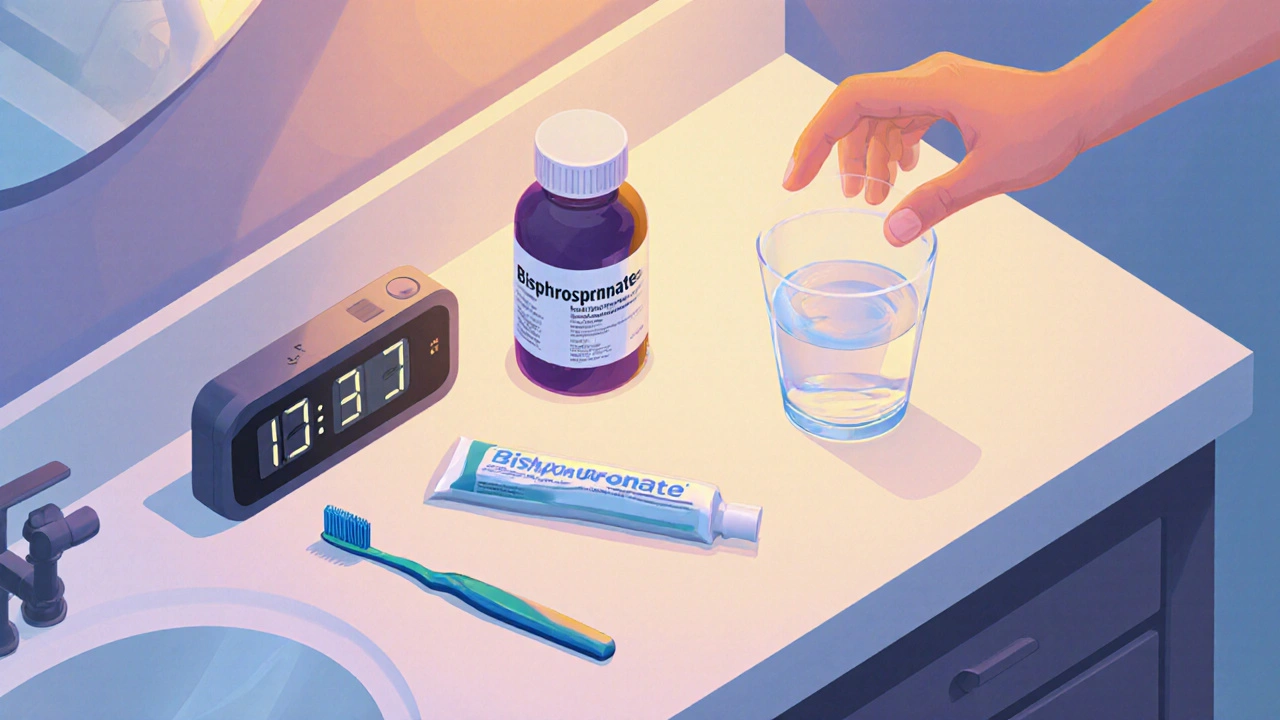Bisphosphonate-Calcium Timing Calculator
Proper Medication Timing Calculator
Calculate the optimal timing between taking your bisphosphonate and calcium supplements to maximize absorption. Based on FDA guidelines and clinical studies.
Recommended Timing
Key Takeaways
- Take oral bisphosphonates with plain water on an empty stomach and wait 30‑60 minutes before any food, drink, or calcium.
- Separate calcium supplements by at least 2 hours from the bisphosphonate dose.
- Stay upright for the entire waiting period to avoid esophageal irritation.
- Consider IV bisphosphonates if strict timing is impossible, but monitor calcium levels before infusion.
- Use reminders, pill organizers, or apps to build a consistent routine.
Ever wondered why your osteoporosis medication sometimes feels like it isn’t working? The culprit is often a hidden chemical tango between calcium supplements and Bisphosphonates - a class of drugs that slow bone loss - and the calcium you take to strengthen those very bones. When they meet in the gut, they form an insoluble complex that the body can’t absorb, slashing bisphosphonate absorption by up to 90%. Below is a step‑by‑step guide to keep the two apart and get the most out of your treatment.
What Are Bisphosphonates?
Bisphosphonates are synthetic compounds whose core is a phosphorus‑carbon‑phosphorus bond. They were first used in the 1960s for bone diseases and became the frontline therapy for osteoporosis after the FDA approved Alendronate (Fosamax) in 1995.
Oral options include alendronate, Risedronate, and Ibandronate. Intravenous forms such as Zoledronic acid (Reclast) are given once a year and bypass the gut entirely.
Why Calcium Throws a Wrench in the Works
Calcium supplements - usually calcium carbonate or calcium citrate - are prescribed to keep serum calcium in a safe range. In the stomach, calcium ions bind tightly to the bisphosphonate molecule, creating a crystal that the intestinal wall can’t pick up. One 2019 study in the Journal of Clinical Pharmacology showed a 94% drop in alendronate absorption when taken with calcium carbonate versus water alone.
The effect is dose‑dependent: calcium carbonate cuts absorption by roughly 94%, while calcium citrate is a little kinder at about 88% (Bone, 2020). Even a sip of orange juice can shave 50‑60% off the dose because the acid promotes calcium‑bisphosphonate binding.
Official Timing Rules - The Gold Standard
All oral bisphosphonates share a strict fasting requirement:
- Take the pill with a full glass of plain water (no coffee, tea, juice, or milk).
- Wait 30 minutes for alendronate or 60 minutes for risedronate before eating, drinking, or swallowing any other medication.
- Remain standing or sitting upright for the entire waiting period.
- Only after the wait can you take your Calcium supplements, other meds, or a meal.
For ibandronate (weekly or monthly), the same 60‑minute rule applies, though the larger monthly dose offers a tiny bit more flexibility because it’s taken less often.

Practical Tips to Make the Schedule Work
Turning a rigid protocol into a habit is the biggest hurdle. Here are real‑world tricks that patients swear by:
- Morning prep station: Place the bisphosphonate bottle, a glass of water, and a timer next to your toothbrush. The timer reminds you when the waiting window ends.
- Pill organizer labels: Use compartments labeled “Bisphosphonate AM” and “Calcium PM.” One 68‑year‑old patient reported a 6.2% rise in hip bone density after 18 months of this system.
- Smartphone reminder apps: The National Osteoporosis Foundation’s free app sends push notifications at the exact times you need to take each product.
- Separate meals: Schedule calcium with dinner or bedtime snack, not breakfast. This guarantees the 2‑hour gap recommended by Osteoporosis Canada.
- Combine with vitamin D: Take vitamin D (e.g., cholecalciferol) with your evening meal. Vitamin D improves calcium uptake but doesn’t interfere with bisphosphonates.
When Oral Won’t Cut It - Switching to IV
If waking up early, remembering timers, and staying upright feels impossible, talk to your doctor about Intravenous bisphosphonate therapy. Zoledronic acid is given once a year (or every two years for some protocols) and eliminates the whole timing drama.
The trade‑off is a 15‑30% chance of an acute‑phase reaction-flu‑like symptoms and a brief dip in calcium levels that usually resolve within 48 hours. Baseline calcium must be checked before the infusion, and a short course of calcium/vitamin D may be given post‑infusion to smooth the dip.
Comparison Tables
| Calcium Form | Absorption Reduction | Typical Dose (mg) |
|---|---|---|
| Calcium carbonate | ≈ 94 % | 500‑1000 |
| Calcium citrate | ≈ 88 % | 300‑600 |
| Calcium gluconate (rarely used) | ≈ 70 % | 250‑500 |
| Attribute | Oral (e.g., Alendronate) | Intravenous (Zoledronic acid) |
|---|---|---|
| Frequency | Weekly or monthly | Yearly |
| Absorption Issue | Highly sensitive to calcium & food | None (direct bloodstream) |
| Common Side Effects | Esophageal irritation, stomach upset | Flu‑like reaction, transient hypocalcemia |
| Cost (US, per year) | $15‑$50 (generic) | ~$1,200‑$1,500 |

Checklist: Your Daily Routine
- Confirm you’ve fasted overnight (no food/drink for at least 8 h).
- Drink a full glass (≈240 ml) of plain water.
- Swallow the bisphosphonate tablet with water - no other pills.
- Start a timer for 30 min (alendronate) or 60 min (risedronate/ibandronate).
- Stay upright; avoid lying down.
- After the timer, take any other morning medicines.
- Schedule calcium and vitamin D with lunch or dinner, at least 2 h after step 5.
- Log the day’s actions in a medication tracker or app.
Troubleshooting Common Problems
Forgot the waiting period? If you ate or drank anything within the window, take a new dose the next morning and keep the missed dose “off‑schedule.” Do NOT double‑dose.
Esophageal pain? Make sure you used only water, stayed upright, and didn’t take the pill with coffee. If pain persists, talk to your doctor about switching to a different bisphosphonate or an IV option.
Calcium level too low? Before starting therapy, get a serum calcium test. If low, a short course of calcium‑rich foods or low‑dose supplements (taken away from the bisphosphonate) can bring you into the safe range.
Bottom Line
The science is clear: calcium and oral bisphosphonates are a bad match in the gut. By respecting the fasting window, staying upright, and separating calcium by a couple of hours, you protect the drug’s tiny absorption window and give your bones the best chance to stay strong.
Can I take calcium carbonate with my bisphosphonate if I forget the 2‑hour gap?
If you realize the mistake within a few minutes, you can still take the calcium after you’ve completed the full waiting period. If you’ve already swallowed the calcium, you’ll need to wait another 30‑60 minutes before taking the bisphosphonate again. It’s safer to skip the dose that day and resume the routine the next morning.
Is it okay to use sparkling water instead of plain water?
No. Carbonation adds acids that can promote calcium binding, reducing absorption. Stick to still, plain water.
Do I need to check my vitamin D levels before starting a bisphosphonate?
Yes. Adequate vitamin D (25‑hydroxyvitamin D >30 ng/mL) supports calcium absorption and reduces the risk of hypocalcemia during treatment.
Can I switch from oral alendronate to IV zoledronic acid without a wash‑out period?
Generally, a short wash‑out (about 7 days) is recommended to avoid overlapping side effects, but your doctor will tailor the plan based on renal function and previous dosing.
What should I do if I experience flu‑like symptoms after an IV infusion?
Drink plenty of fluids, take acetaminophen if needed, and contact your provider if fever exceeds 38°C or symptoms last more than 48 hours.
